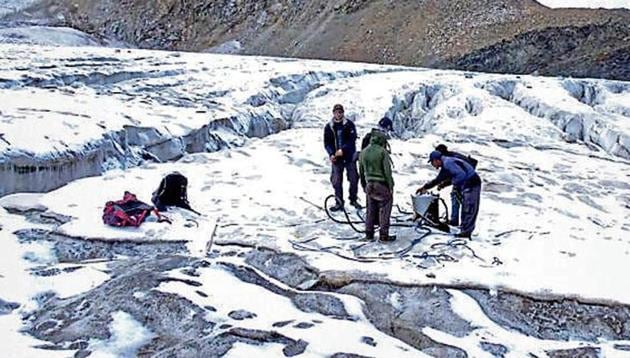Melting glaciers threaten water reserves in Sutlej tributaries
The Sutlej along with its tributaries acts as a Himalayan power house, thanks to its hydroelectricity generation potential. More than 50% of the river’s annual flow comes from melting of snow.
The Himalayas in Himachal Pradesh are bearing the brunt of global climatic change as glaciers in the basins of two of the Sutlej’s main tributaries — Baspa and Spiti — are melting at a rapid pace.

This has worried both the government and environmentalists in the state.
Glacial melting would result in hydrologic variations in the snow-fed rivers and will impact the dams and water reservoirs in future as scientists have projected an increase in temperature by 5 degrees Celsius.
The Sutlej along with its tributaries acts as a Himalayan power house, thanks to its hydroelectricity generation potential. More than 50% of the river’s annual flow comes from melting of snow.
But this flow could get drastically change in the coming years, shows the latest study ‘Monitoring and Estimation of Mass Balance of Glaciers with Different Aspects in Baspa Basin Using Space Data and Their Validation’ conducted by the Himachal Pradesh Centre on Climate Change (HPCCC).
The fresh data reveals that the river’s water reserves, which are dependent on glaciers, are likely to vary substantially in future due to climate change as glaciers are highly sensitive to variations in temperature and precipitation.
At least 2,026 glaciers add up to make the Sutlej. The Baspa river basin has lost 3.9 % of glacial area in the last eight years, while the numbers of glaciers fragmenting at an alarming speed in the Spiti river basin as well.
Environmentalists concerned
“Rapidly melting glaciers may impact the hydro projects in two ways. In the short run, the threat of rapid and large amount of discharge due to glacier lake outburst floods (GLOFs). These have the potential to damage the projects the way it happened in Kinnaur in 2005. In the longer run, a decrease in river discharge would mean drier rivers and thus the production of power will come down,” says Palampur-based environmentalist Manshi Asher.
The study observes that the glacial melt in the Baspa, particularly in the north-eastern side, has increased in the past eight years.
According to the satellite images mapped by scientists, the area under 79 glaciers has started to show signs of cracks even as they are still intact. The Baspa basin has shrunken from 158.53 square km in 2001 to 153.68 square km in 2018.
Melting is prominent in the south-west, south-east and eastern side of the basin that has lost 3.9% of the total area from 2001 to 2018.
The area till 2011 had reduced to 155.38 square km and it was 153.68 square km n 2018.
The scientists attribute the glacial melt to rising temperatures and less snowfall on the river basin.
“Deglaciation (disappearance of ice from an erstwhile glaciated region) has accelerated due to rising temperatures. The south-west and south-eastern parts of the river are more exposed to sunlight,” says HPCCC principal scientist SS Randhawa who has been studying the phenomenon in the Himalayan rivers for the last three decades.
Fragmented glaciers in Spiti basin
Glaciers in the Spiti river are also melting at a rapid pace besides being fragmented. It was detected through glacial mapping that the large-sized glaciers in the basin have fragmented into multiple small-sized glaciers owing to rise in temperatures.

The HPCCC had recorded 201 glaciers in 2001, which grew to 228 in 2013.
“An analysis of satellite data revealed that smaller glaciers having area less than 1 square km have gone up with 291 in 2001, as many as 300 in 2007 and 309 in 2013.
Overall, about .94% of the total area of small-sized glaciers in the basin has been lost between 2001 and 2007 and 4.91% between 2007 and 2013.
Glacial melt will be higher for smaller glaciers because of their shorter response time and more surface area, thus making them more vulnerable to climate change. As per a study, glaciers with area less than 1 sq km will experience 62% of area loss by 2050, while bigger glaciers with an area of more than 10 sq km show a slower response to climate change with only 1% loss.
“Though the number of smaller glaciers is increasing, the total area under these small-sized glaciers is going down,” said scientist Pooja Rana.
Melting glaciers are also giving rise to new glacial lakes which are dangerous as they could trigger devastation similar to what was experienced in Uttarakhand in 2013.
Glacial lake breach in Pareechu, a tributary of Spiti, wreaked havoc in 2004.
Randhawa says the size of the lake formed by melting of the Gepang Gath glacier has increased to 118 hectares from just 27 hectares in 1965. The scientists have called for adopting preventive measures before the expanding lake wreaks havoc in future.
Get Current Updates on India News, Lok Sabha Election 2024 live, Infosys Q4 Results Live, Elections 2024, Election 2024 Date along with Latest News and Top Headlines from India and around the world.




